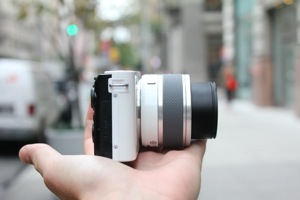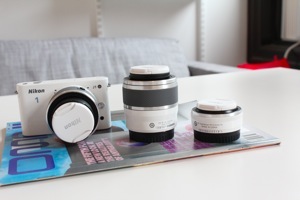Small-bodied interchangeable-lens cameras are the future of photography, and everyone knows it. At their best, they bring DSLR-like control and quality to cameras with much smaller bodies. That’s what Sony went for with the NEX-3, and what Olympus and Panasonic did with their Micro Four Thirds cameras. Two big names have been missing from this list, though, and that’s Nikon and Canon. Neither camera goliath released an interchangeable-lens camera that isn’t a DSLR, until Nikon finally unveiled the J1, the first of its new 1 series. On paper, the $649.95 J1 stacks up well against its competition — competitive price, small body, multiple lenses. But how does it stack up in the real world? Can Nikon come into this market late and dominate it, as it did with DSLRs? Read on to find out.



One thing the J1 has going for it: it's great-looking. Thanks to its flashy colors — it comes with a glossy white, black, red, silver, or pink front, and a black back — and 4.2 x 2.4 x 1.2 -inch body, it looks more like a compact camera than a DSLR. It's still too big to fit into a pocket, though, and it's so heavy it'd pull your pants down anyway. It weighs 13 ounces, but feels much heavier; since there's no grip, and the finish on the camera is a little slippery, it's hard to hold on to. The Sony NEX-C3 has a little bit of grip that makes it easier to hold, even though it's about the same size. Overall it's a sleek, minimal device without a lot of buttons or wheels marring its good looks; it's nicer to look at than the Canon Powershot G12, a similar high-end point-and-shoot camera that is absolutely littered with controls, and is more like a larger version of the also-comparable Powershot S95.
Since the Nikon J1 has neither a viewfinder nor an accessory port for adding one, the screen becomes incredibly important. Luckily this one's a good one, a sharp, 3-inch LCD that's filled with 460,000 dots. It's very accurate as well (though it occasionally showed white balance problems that didn't exist in photos), and easy to see in direct sunlight. Once again, though, it's not as good as its price necessitates; the NEX-C3 and the Olympus PEN E-P3 fill their screens with 921,000 and 640,000 dots respectively, and both outshine (figuratively and literally) the J1. The LCD also doesn't swivel like some of its competitors' do, which limits the angles at which you can shoot.
The 10-megapixel shooter has three lenses available to it: the kit lens is a 10-30mm zoom with Nikon's VR image stabilization — it's about the same size as a 27-81mm zoom on a standard 35mm camera. That's not as wide as you might like to get with your photos, which I noticed especially when shooting landscapes and buildings — I always had to back up further than I thought to get the whole shot with the J1. There's also a $249.95 30-100mm zoom lens, which is great for close-ups but terrible for most everyday shooting since it starts so close. Those two zooms were okay, but neither is particularly bright or fast, and I ended up using the $249.95 f/2.8 pancake lens the most because it was bright enough to compensate slightly for the J1's awful low-light performance. None of the three lenses offer manual focusing, which ought to be a non-starter for experienced shooters; having multiple lenses is a lot less worthwhile when you can't manually focus except on the camera. You can use other Nikon lenses on the J1 (and you'll have to if you want manual focusing), but you'll need an adapter. Nikon is clearly trying to bring point-and-shoot simplicity to a more complex and feature-rich camera with the J1, but it made a lot of wrong choices in what to cut.
Interface and Controls
The lack of controls on the J1 makes no sense


Another prime example of Nikon's over-simplification of the J1 is the lack of manual controls. Nikon's DSLRs do a great job making every function you'd need just a click away, or a spot on a dial, and it ignores that here. There's the shutter press and a dedicated "start recording video" button, and that's about it up top. The mode dial that's normally on top of the camera is on the back, and inexplicably only scrolls between four modes, none of which are Shutter or Aperture Priority, or Manual mode. To get to those, you have to dig into the menu system, which is a pain to do every time you want to switch. The dial isn't full anyway, and it doesn't make sense that Nikon would rather waste the space than include a few more options; once again, simplicity trumps usefulness. The Olympus E-PL3‘s mode dial makes manual shooting a much faster and easier experience, and though the NEX-C3 doesn't have one its menu system is at least easy to navigate.
Since there are so few manual controls, the menu system on this camera is critical, and it's mostly up to the task. Most things are placed where they should be in the menu system, and there aren't so many menus as to be difficult to find. The test the J1 doesn't pass, though, is the "hand it to a stranger" test. Since there aren't many controls, the ones that do exist have to multi-task, doing different things depending on the mode you're in — like when you use the zoom button to change shutter speed or the menu scroll wheel to change aperture, a fact that might take a few minutes and a lot of errant button pressing to figure out. I'd guess most users will use the Auto mode, so this isn't too much of a problem, but there's more of a learning curve than there should be.
Features
Smart Photo Selector was the one shooting gimmick I used more than a couple of times
The J1 is full of shooting gimmicks that do unusual things with your photos. While you won't find any super-trendy Instagram-style filters, what is present is Motion Snapshot mode, which takes a one-second video before and after a still shot, adds music, and and plays the video before fading into the still shot. It's a neat trick, and always funny given the music choices — you choose Relaxation, Waves, Beauty or Tenderness — but not something I'd ever imagine using except to show off the feature. There's also a slow-motion option in video recording, which shoots five seconds of video at an incredibly high frame rate — 400 or 1200 fps — and then converts it to a minute or so of slow-motion footage. This might actually be useful, except that to shoot that fast the J1 has to shoot at 640 x 240 or 320 x 120 resolutions, which really don't look good anywhere but on your camera's small screen. Also people moving that slowly are creepy.
Smart Photo Selector was the one feature I used more than a couple of times. It shoots 60 photos with one press of the shutter, and algorithmically picks five of them to keep. It tosses out blurry or dark shots, followed by shots where someone is blinking or not smiling, and tries to find the best of the bunch. I can't say for sure that the selector never threw out a good photo, but it did always leave me with a couple of good ones to choose from.
Performance and Quality
As soon as you lose daylight or go indoors, the J1's image quality falls off a cliff

As long as lighting is good, the J1 takes excellent photos. I used the camera to shoot at a farm, and photos of animals, running children, and landscapes all turned out sharp, with accurate and rich colors. When the camera is able to use a fast shutter speed, it produces nice results. As soon as you move indoors or shoot in anything other than broad daylight, though, the camera’s quality drops like a stone. The small sensor forces the shutter to stay open a long time in low-light situations, which means blurry images when you're not shooting a still life from a tripod. You can also crank up the camera’s ISO sensitivity as high as ISO 3200; it does all right, but having to choose between soft images at high ISOs and blurry images at low ones is a bummer of a trade-off. Taking sharp pictures of my cousin throwing a football was easy in the daylight, but as the sun set he started to look more like a phantom moving through the night, unable to be captured standing still — even when he was standing still.
When you shoot with a DSLR, you do it both for the quality and the style — the soft-background feel that makes subjects pop. The J1 can't do that. The small sensor can't take in much light at a time, so the J1 is mostly unable to do any kind of focusing magic. The problem could be somewhat compensated for by a super-bright lens, but there isn't one available for the J1, so if you're looking for bokeh and soft backgrounds, look elsewhere.
There's a button on the back of the camera that slides to the left to pop up a cheap, periscope-looking flash that I can't look at without thinking it belongs in Wall-E. It sticks up precariously a couple of inches above the camera, and is bright given how small it is, but it won't adjust or rotate, which means using it as a bounce flash (which provides more natural-looking light) is impossible. It's nice that there's one included at all, since neither Olympus' Micro Four Thirds cameras nor the NEX shooters have one, but it's not a good flash, and since there's no accessory port you can't add on a better one like you can with its competitors.
The J1's greatest strength is its speed: this camera is blazing fast
I was impressed with the J1's video recording capabilities. The camera can shoot 1080i/60, 1080p/30, or 720p/60 video, and all three looked good, though both 1080 settings produced slightly over-saturated blacks that made the whole video feel a bit dark. 720p60 is always my favorite mode for shooting, because it captures action so smoothly. The camera can zoom and autofocus while recording video, and it does it both quickly and quietly — that's a rare feat for any camera. It can also shoot a still image while recording video, without any noticeable effect on either except that the still image takes on the same 16:9 aspect ratio as the video.
The camera's real strong suit is its speed: it is blazing fast, in nearly every operation. Autofocus is one of the most noticeable, locking on almost immediately with a half-press of the shutter. By default, it's always looking to focus, so even by the time you frame your shot it's already in focus. You can turn off this setting, and you might want to — cool as it is, it's a huge drain on the battery. The J1's fast enough to handle action shots, or capturing quick moments; the focus never once slowed me down in using the J1. The one tradeoff with this super speed is that it's not very consistent; the J1 would often pick a different thing to focus on every time I half-pressed the shutter, and I'd have to do it a few times before I got the actual subject in focus.
The camera takes about two seconds to turn on, and then shoots with virtually no shutter lag or recycle time — though if you shoot continuously, the camera slows down significantly after about 40 shots. As long as you have excellent light, and don't run into the slow-shutter-speed problem, the camera is great for action shots.




Video Review
The Nikon J1 is a barely-disguised point-and-shoot with a bunch of lenses and a $650 price tag
Calling the J1 a high-end camera is like putting a Honda engine into a Ferrari's body, and calling it a Ferrari. The Nikon J1 looks and feels like the expensive camera it is (except for that flash), but if you peek under the hood you'll find a sub-par engine (the sensor, in this case). Like a Honda, the J1 works pretty well, and even has some clever features baked in -- but if you're paying for a Ferrari you expect a Ferrari, and that's just not what the Nikon J1 is. It's a high-end point and shoot priced like a low-end DSLR, and the addition of interchangeable lenses doesn't make up for the small sensor inside. At a lower price it could be compelling, but at $650 it's firmly in the price range of cameras like the Sony NEX-C3 and the Olympus E-PL3, both of which produce better images in more situations than the Nikon J1.
:format(webp)/cdn.vox-cdn.com/uploads/chorus_asset/file/13062127/Hero.1419962192.jpg)
:format(webp)/cdn.vox-cdn.com/uploads/chorus_asset/file/13062127/Hero.1419962192.jpg)
Share this story